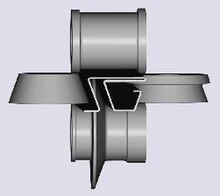Profiling process
A profiling process is a technical process in which workpieces with a defined cross section (profile) are formed from sheet metal with the help of profiling systems. The most important process in the industrial production in particular of steel profiles is the roll forming (including roll forming or cold rolling of profiles , engl. Roll forming ). The roll forming Verfahrensguppe belongs to the roll bending , for the bending deformation counts. Branches in sheet metal profiles can be created by gap profiling.
Roll forming
In roll profiling, an originally flat sheet metal strip is fed through up to 60 and more modularly lined up and driven pairs of rollers at up to 120 meters per minute until the desired profile shape is bent. Profiling systems can be 100 and more meters long, depending on the requirements that a product should meet within a work process. The sheets are from 0.1 millimeters thick, with a strip inlet width of usually eight millimeters, for example for decorative strips up to 1.2 meters wide for trapezoidal sheets for roofing. Despite all the forming steps within a process, the sheet thickness always remains approximately constant.
The profile shape is arbitrary; simple and complex cross-sections can be produced in this way. A separate tool set (roller set) is required for each profile cross-section . To do this, you first design the profile flower , i. This means that the cross-sectional shape is determined for each forming stand. Then you design the shape of the roller tools.
Roll forming is a particularly cost-effective manufacturing process when larger lengths or larger quantities are to be produced. The combination of profiling with other processes such as punching , longitudinal welding or embossing enables a wide range of shapes without having to heat the sheet metal, as well as high production output with exactly the same quality. It is regulated as a multi-stage forming process with rotating tool movement in DIN 8586 .
Slide bending
Slide bending offers another variant of profile production. The workpiece is pulled through several dies until it has the desired profile shape. This process results in only low tool and system costs and the machines can be quickly converted to other profile specifications. This means that smaller quantities can also be produced in variable lengths.
application
Roll-formed profiles are in demand above all in logistics (shelves), in construction (assembly, formwork systems), in automobiles (bumpers, side impact parts, interior), in the electrical industry (switch cabinet construction), the solar industry (assembly) and household technology (decorative strips) .
literature
- Michael Henkelmann: Conventional roll forming . In: Development of an innovative calibration line to increase profile accuracy when processing high-strength and ultra-high-strength steels (= reports from production and forming technology . Band 77 ). Shaker, Aachen 2008, p. 3 ff .
- Hartmut Hoffmann , Günter Spur , Reimund Neugebauer : Roll forming . In: Handbook Forming . Hanser-Verlag, Munich 2012, ISBN 978-3-446-42778-5 , p. 594 .
- Horst E. Friedrich: Lightweight construction in vehicle technology . Imprint: Springer Vieweg, Wiesbaden 2013, ISBN 978-3-8348-1467-8 , doi : 10.1007 / 978-3-8348-2110-2 .
- Heinz M. Hiersig : Slide bending . In: Lexicon production engineering, process engineering . Springer-Verlag, Berlin 2013, ISBN 978-3-642-57851-9 , pp. 402 ( books.google.de ).
Web links
- Leaflet 180: Roll forming of flat products made of steel. (PDF) on stahl-online.de
- Production process "roll profiling". on imw.tu-clausthal.de
- Slide bending: Profiling and bending in one go. on industrieanzeiger.de
Individual evidence
- ↑ Forming technology: slide bending as an alternative to the production of load-adapted profiles. (PDF) on files.vogel.de, p. 18 ff.


